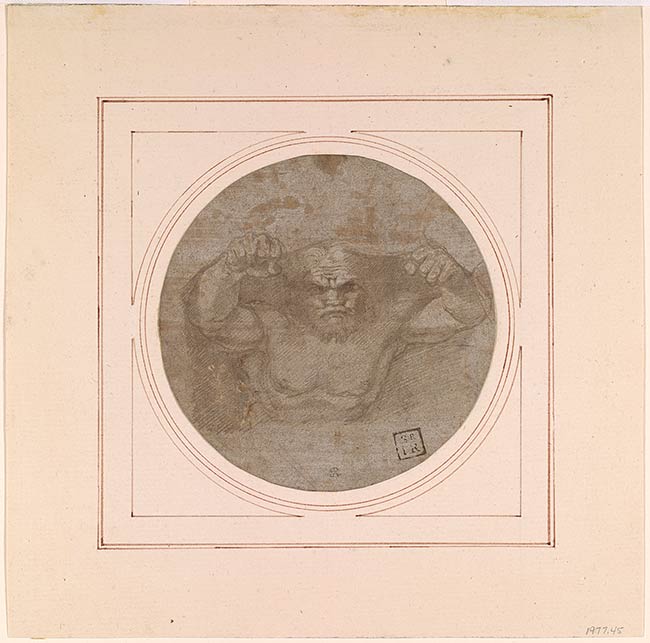
Although Raphael received a constant stream of commissions from private patrons and religious organizations throughout his short career, his greatest works were those made to satisfy papal commissions. The artist spent his last twelve years in Rome, from 1508 until his death in 1520, working for Pope Julius II, Pope Leo X, and their courts. He designed and in part completed the enormous fresco cycle in the Vatican stanze—the frescoes in the Stanza della Segnatura being among the most famous—and, in 1515–16, made ten cartoons for tapestries for the Sistine Chapel illustrating scenes from the lives of SS. Paul and Peter based on the Acts of the Apostles. The cartoons were sent to Brussels, where the tapestries were woven; seven of the cartoons have been preserved in the Victoria and Albert Museum, London.
The present study, a virtuoso performance combining refined draftsmanship with powerful subject matter, relates to the tapestry project. Inspired by a figure on an antique sarcophagus relief in the Villa Medici, Rome—identified alternatively as Uranus or as Coelus, the personification of heaven1—the fierce old man in Raphael’s drawing was used for the figure of an earthquake in the Sistine Chapel tapestry St. Paul Released from Prison by an Earthquake.2 The lines above the head in the drawing still suggest the veil that is Coelus’s attribute, but these were eliminated in the tapestry. For the final version, Raphael showed the personified earthquake breaking through the ground with his fists. The drawing is in reverse direction to the tapestry, as are all of Raphael’s known drawings for this tapestry series. Its importance must have been recognized early on: the drawing was engraved by James Basire in 1767 while in the collection of Sir Joshua Reynolds, one of the foremost English connoisseurs of the time.3 There is what appears to be a fragmentary cartoon for the same figure—possibly by Raphael’s close collaborator Giulio Romano—in the collection of the Earl of Wemyss at Gosford House, Longniddry.4 As is usual for tapestry cartoons, it is in the same direction as the related tapestry.
An additional drawing in the Morgan’s collection, a large compositional study of the Adoration of the Magi, is also related to Raphael’s tapestry designs, although to a later series illustrating the Life of Christ.5 These tapestries are usually referred to as the scuola nuova series to distinguish them from the earlier Acts of the Apostles set. Pope Leo X initiated the project, and most of the designs and cartoons were probably made during his papacy. Eleven tapestries of the original series of twelve survive. Considered by some the most successful of the group, the Adoration of the Magi was almost certainly made during Raphael’s lifetime and under his supervision, although the Morgan drawing was made late in the design process and probably by a member of the master’s workshop.
The use of metalpoint on prepared paper as seen in Male Figure Representing an Earthquake belonged to an earlier Florentine tradition and was favored by Raphael in his early years. By 1515, however, he preferred to use pen and ink and occasionally red chalk for his compositions. Together with a study in the J. Paul Getty Museum, Los Angeles, for the figure of St. Paul in the Sacrifice at Lystra,6 the Morgan Earthquake is one of the latest of Raphael’s extant metalpoint drawings. With minimal strokes, the artist conjured the looming figure and described the complicated foreshortening of the arms. He used parallel hatching to create faceted shapes of dark and light. The highlighted areas of the broad nose and forehead project forward, the shadowy eyes darkened by the heavy brow. The sheet is tiny and the lines economically placed: seldom has an artist created so much with so little.
—REP
Footnotes:
- For the relief depicting the Judgment of Paris, see Bober and Rubinstein 2010, no. 119.
- Vatican Museums, Vatican City, inv. 43875. See London 2010, no. 9.
- Rogers 1778, 1:46.
- Gosford House, Longniddry, inv. 460. See Kauffmann 1964, 123–24 and 129.
- Vatican Museums, Galleria degli Arazzi, Vati- can City. See New York 2002, 238.
- J. Paul Getty Museum, Los Angeles, inv. 84.GG.919.
Watermark: none visible through lining.
Richardson, Jonathan, 1665-1745, former owner.
Reynolds, Joshua, Sir, 1723-1792, former owner.
Scholz, János, former owner.
Rhoda Eitel-Porter and and John Marciari, Italian Renaissance Drawings at the Morgan Library & Museum, New York, 2019, no. 37.
Selected references: Rogers 1778, 1:46; Fischel and Oberhuber 1913-72, 9:136-37; Bloomington and elsewhere 1958, no. 18; Cologne 1963-64, no. 128; Kauffmann 1964, 123-30; Milwaukee 1964, no. 32; New Haven 1964, no. 36; New York 1965-66, no. 50; Houston 1966, no. 40; Colorado Springs 1967, no. 2; Dussler 1971, 104; Shearman 1972, 104-5; Washington and New York 1973-74, no. 1; Notre Dame 1980, no. 141; Joannides 1983, 224; Knab, Mitsch, and Oberhuber 1983, no. 525; Notre Dame 1983, 72-73; New York 1987, no. 29.
Stampfle, Felice, and Jacob Bean. Drawings from New York collections. I: The Italian Renaissance. New York : Metropolitan Museum of Art : Pierpont Morgan Library, 1965, no. 50, repr.
Oberhuber, Konrad, and Dean Walker. Sixteenth Century Italian Drawings From the Collection of János Scholz. Washington, D.C. : National Gallery of Art ; New York : Pierpont Morgan Library, 1973, p. 1, no. 1, repr.
Ryskamp, Charles, ed. Nineteenth Report to the Fellows of the Pierpont Morgan Library, 1978-1980. New York : Pierpont Morgan Library, 1981, p. 291-292.
